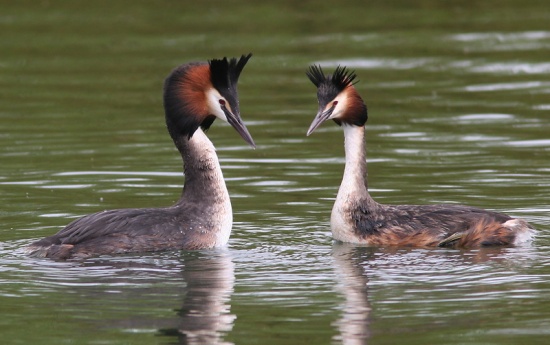- Podiceps cristatus
Identification
The largest Old World grebe
L. 46–61 cm (18-24 in)
Ws. 87cm
- Large
- Long neck
- Long, pinkish bill
Adult breeding
- Dark greyish brown above
- White below
- Rufous flank
- Black crown and crest
- Ear coverts form facial ruff
- Chestnut tipped with black
- Black lores
- Face, chin, throat and foreneck white
- Black hindneck
- Grey sides of neck
- Red iris
- Olive-green to yellow legs
Adult Non-breeding
Eurasian birds lose facial ruff and crest and become much duller and greyer
African and Australasian birds show much less seasonal variation.
Juvenile
Similar to non-breeding adult but has striped head and upper neck
Flight
Shows bold white scapulars and leading and trailing edges to wing.
Distribution
A widepread Old World grebe breeding in Eurasia, Africa and Australasia.
Europe
Breeds across most of the continent from Iberia and the British Isles eastwards ranging north to central parts of Sweden and Finland and south to the Mediterranean coast and Turkey. Range extends eastwards across Asia to China and locally in Japan but absent from most of Arabia, India and South-East Asia.
Africa
Breeds, or formerly bred, at a few scattered localities in the north in Morocco, Algeria and Tunisia but more widespread, although discontinuously, south of the Sahara. Breeds in Ethiopia, Kenya and Tanzania, and in the south in Namibia and South Africa.
Australasia
Range is confined mainly to the east in central an southern Queensland, New South Wales and southern South Australia, but also occurs in Tasmania and the south-western corner of Western Australia. In New Zealand occurs on South Island and most numerous in South Westland.
Resident in Western Europe but migratory to the east and more widespread around the Mediterranean, Black and Caspian Seas in winter. East Asian birds winter in southern Japan and southern China. Australian birds are probably resident or nomadic.
Taxonomy
Subspecies
Three subspecies are usually recognised[1]:
- Nominate race in Eurasia and North Africa
- infuscatus (smaller and darker, lacks white over eye and reduced seasonal variation) in sub-Saharan Africa
- australis (reduced seasonal variation) in Australia and New Zealand
Habitat
Fresh or brackish waters, usually medium-large with emergent vegetation, often on artificial reservoirs and gravel pits. Moves to estuaries, sheltered bays and coastal inlets in winter.
East African birds breed mainly on mountain lakes.
Behaviour
Breeding
Breeds April-September in Europe, throughout the year in Africa and November-January in Australia.
Courtship display is lengthy, elaborate and involves paired dancing and ritualised gift-giving of bits of plant matter.
Nest is a heap of vegetation in reedbeds, sometimes anchored to emergent plants or on the bottom in shallow water.
Eggs: 4 (sometimes 3-6), white initially soon becoming stained (55 x 37mm, in Australia 50 x 35mm). Incubated by both sexes for 25-26 days. Young tended by both sexes, independent at 42 days but may remain with parents for up to 72 days. Single-or double-brooded.
Diet
Fish and aquatic insects and their larvae, crustaceans and molluscs caught in 30 second dives.
Vocalisation
A range of barking, trumpeting, wailing and growling calls
<flashmp3>Podiceps cristatus (song).mp3</flashmp3>
Listen in an external program
References
- Clements, J. F., T. S. Schulenberg, M. J. Iliff, D. Roberson, T. A. Fredericks, B. L. Sullivan, and C. L. Wood. 2015. The eBird/Clements checklist of birds of the world: v2015, with updates to August 2015. Downloaded from http://www.birds.cornell.edu/clementschecklist/download/
- Handbook of the Birds of the World Alive (retrieved February 2016)
Recommended Citation
- BirdForum Opus contributors. (2024) Great Crested Grebe. In: BirdForum, the forum for wild birds and birding. Retrieved 30 May 2024 from https://www.birdforum.net/opus/Great_Crested_Grebe
External Links









